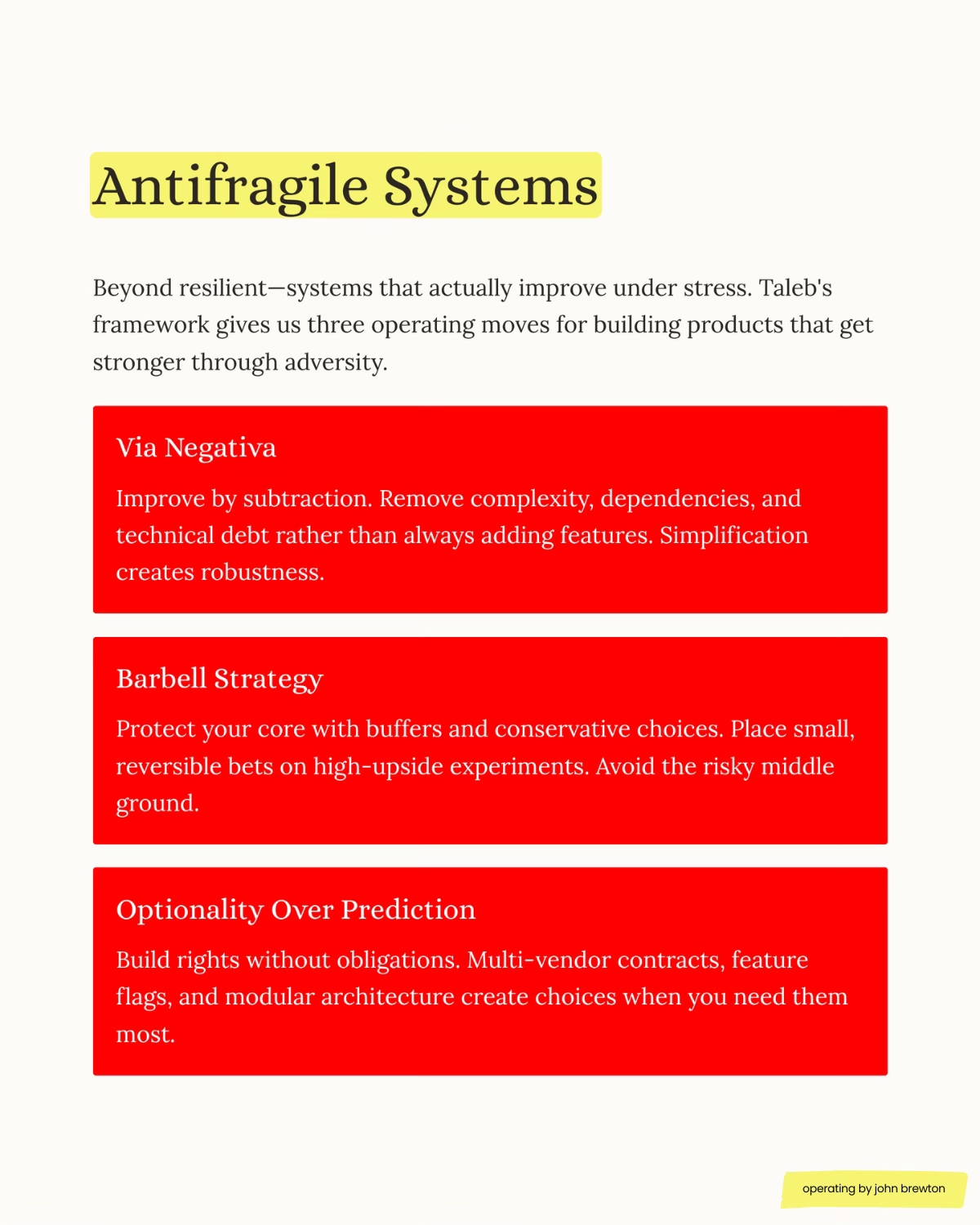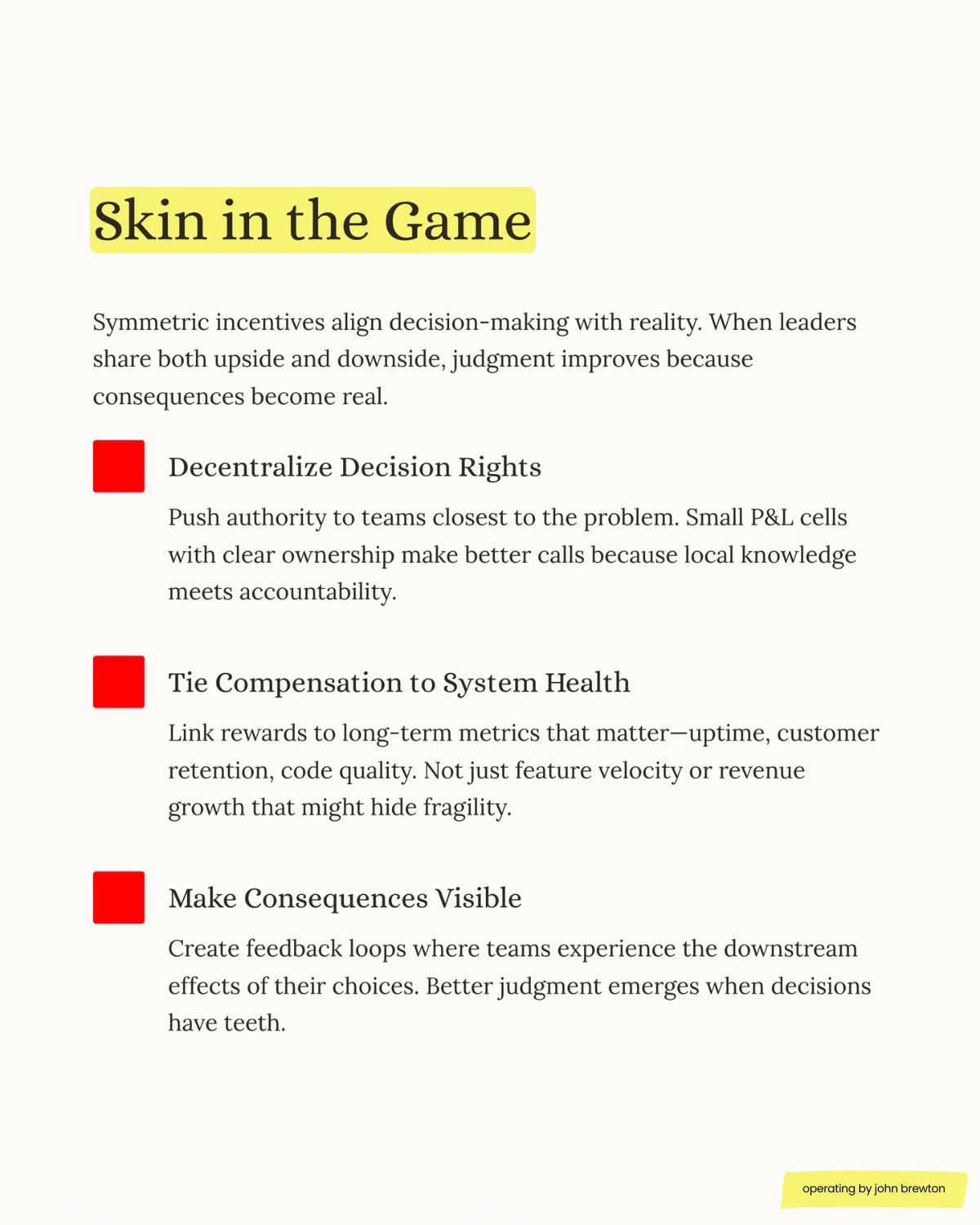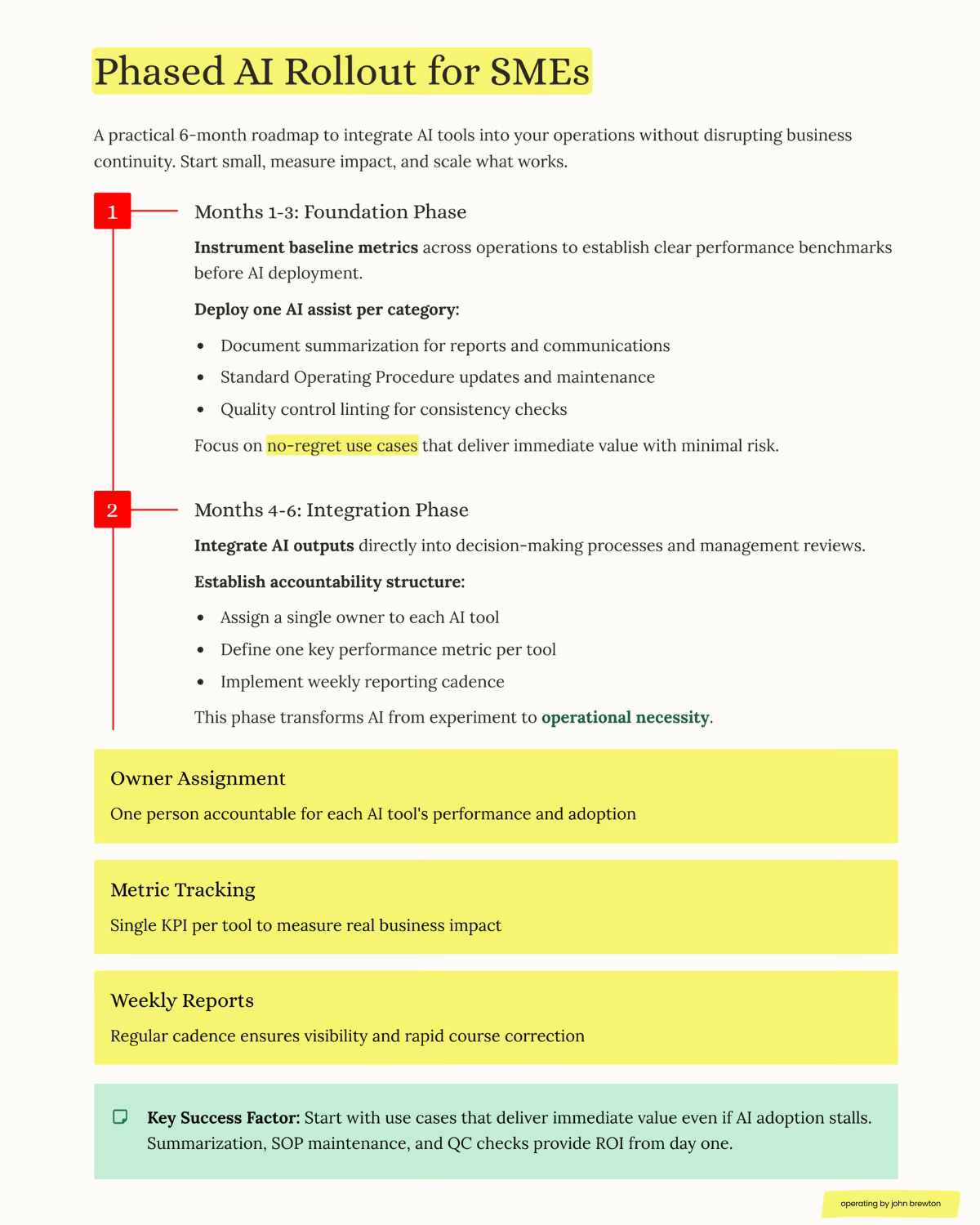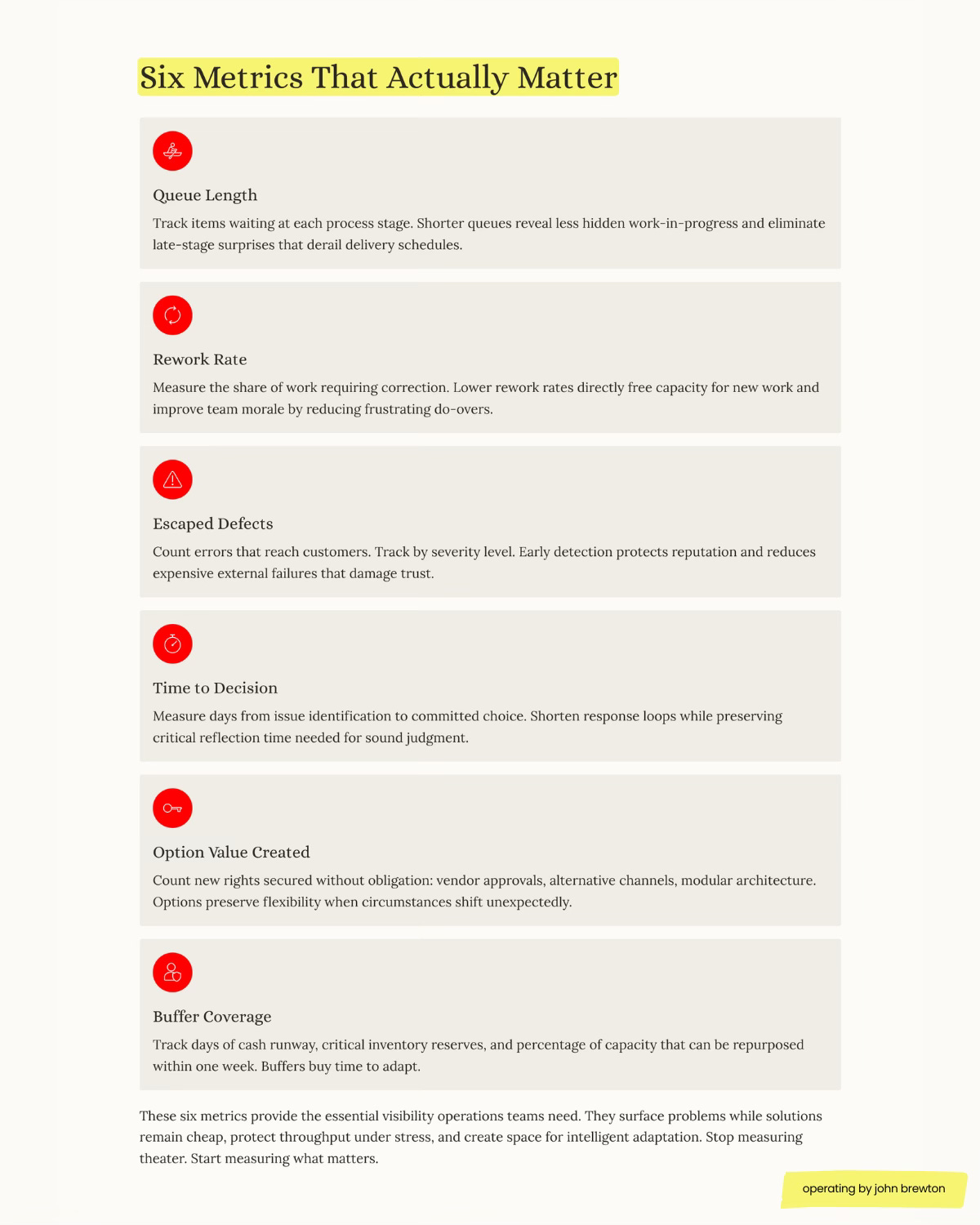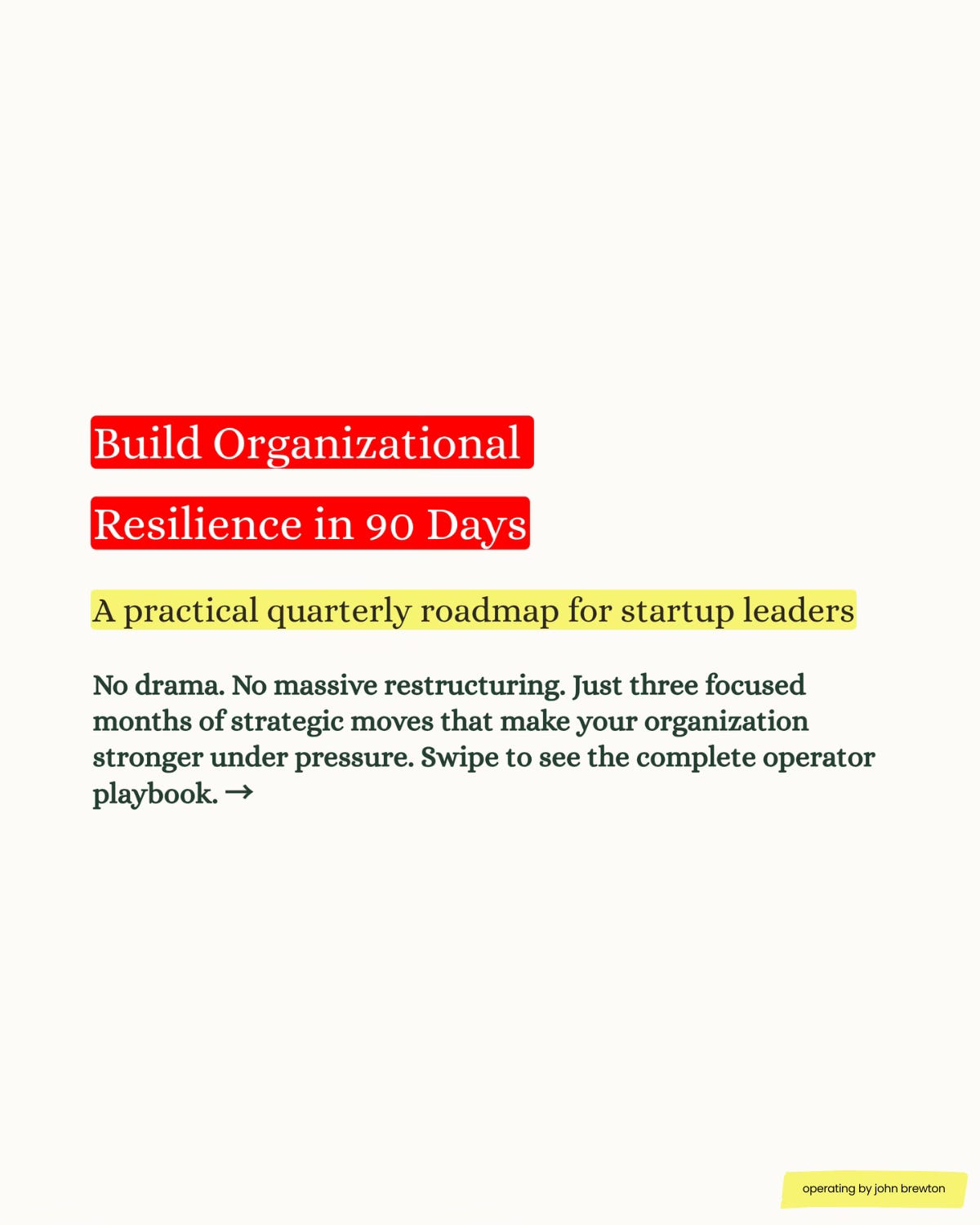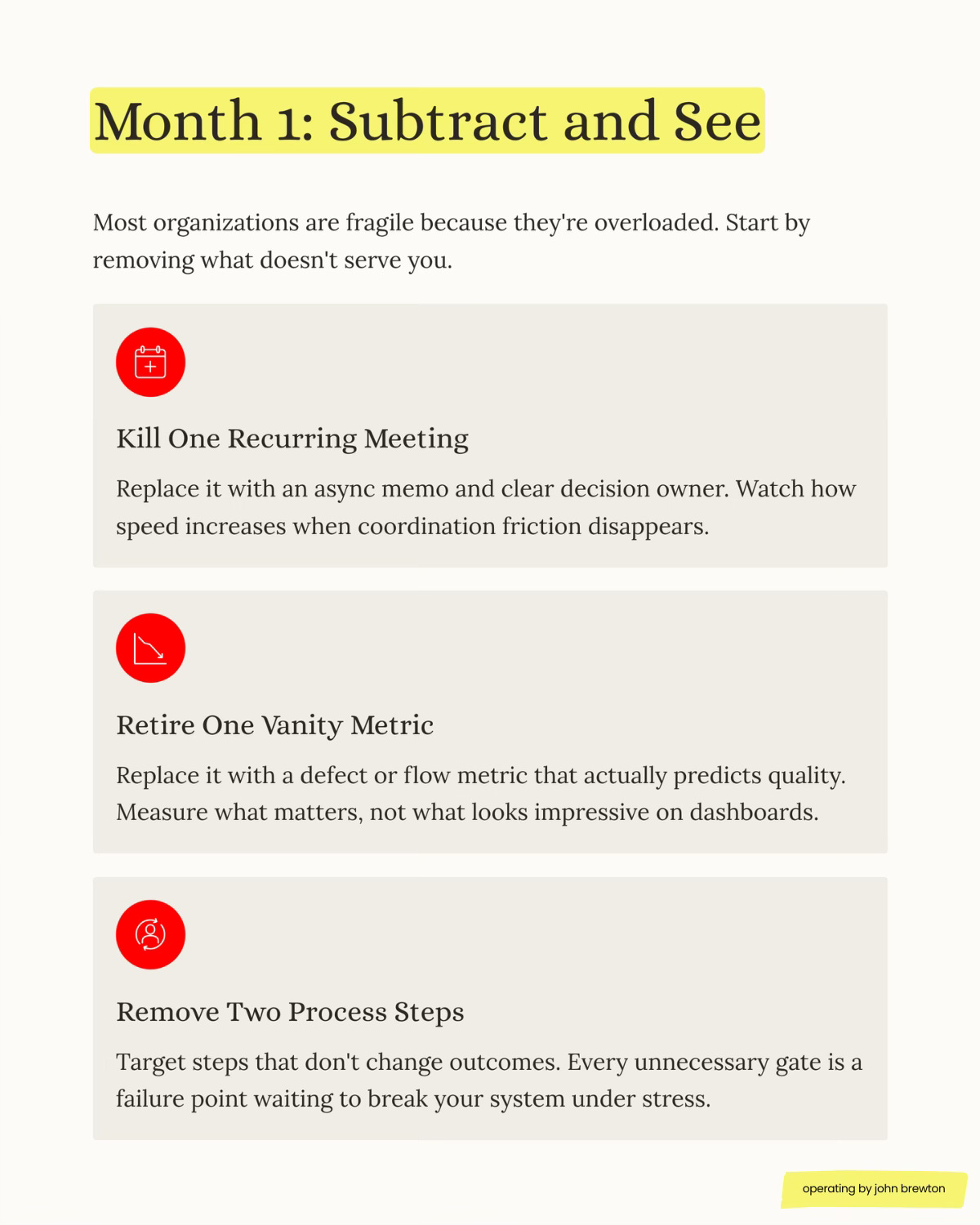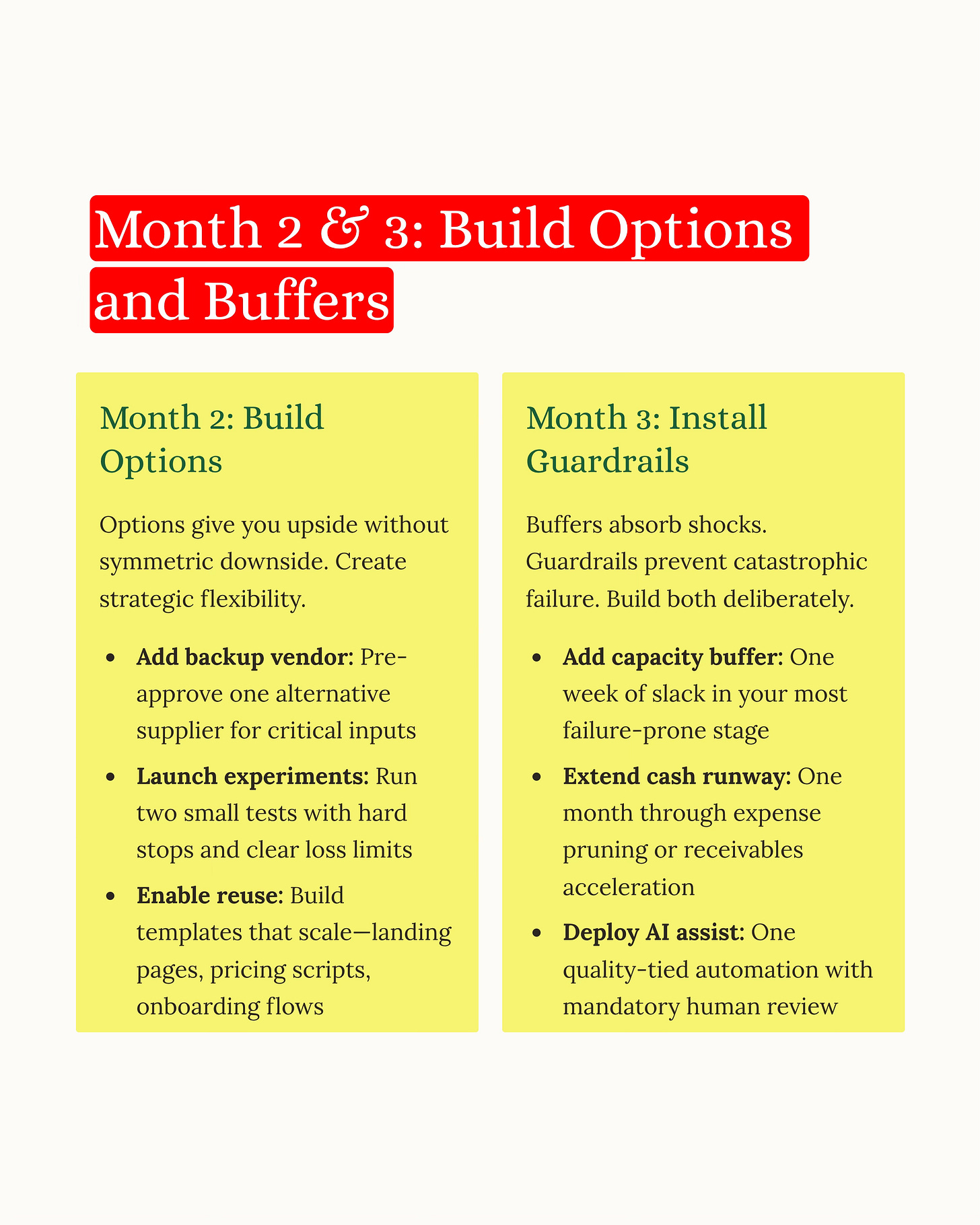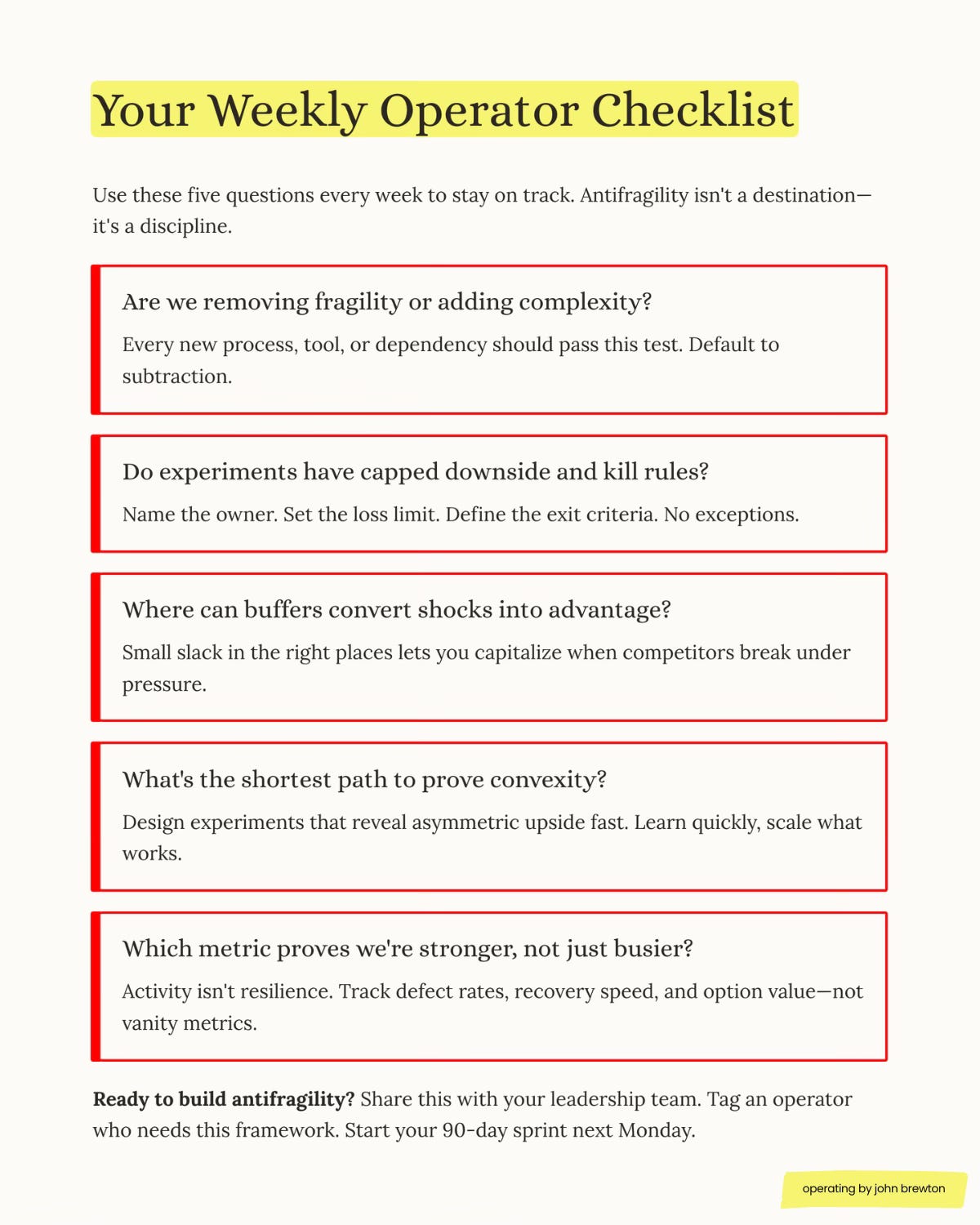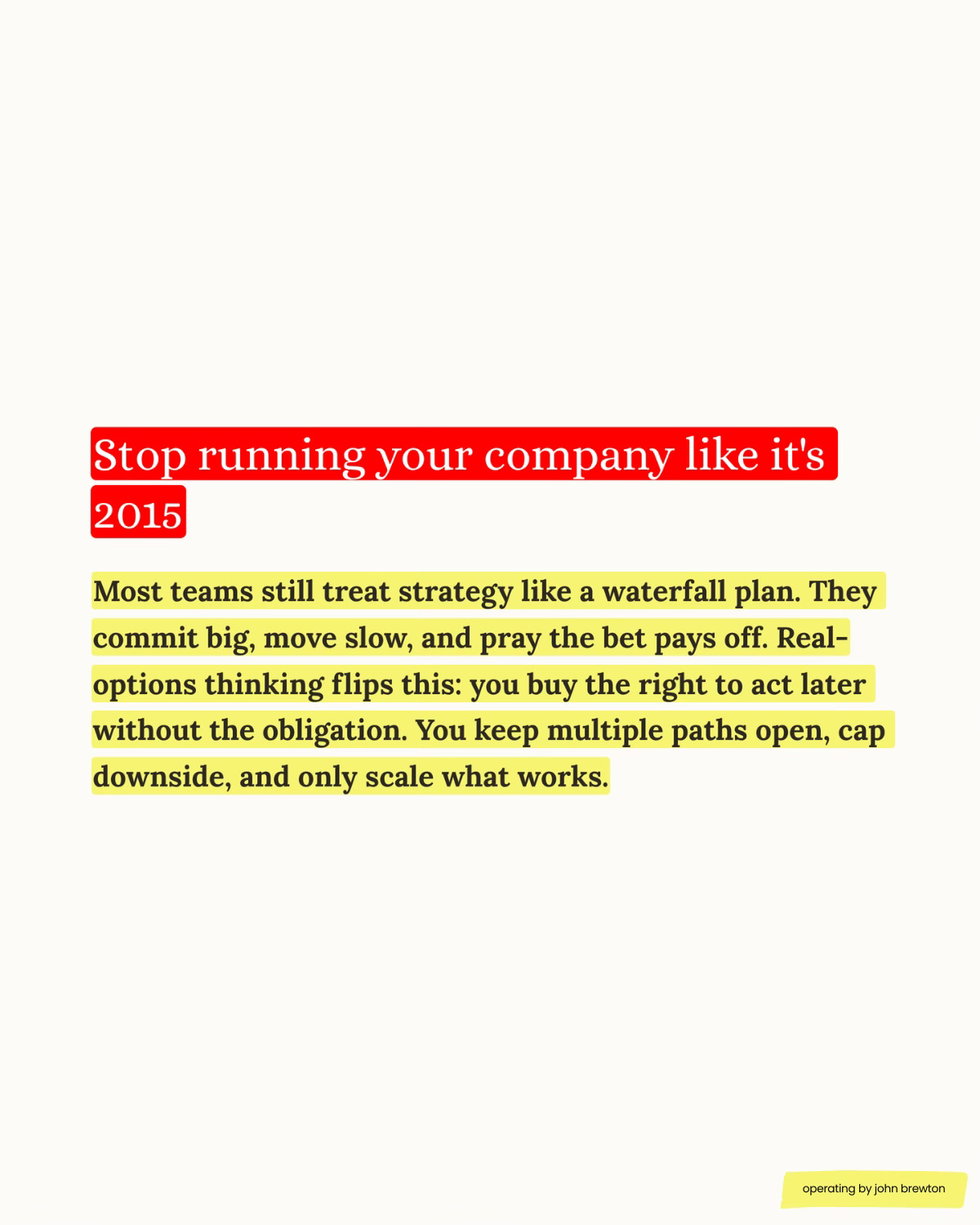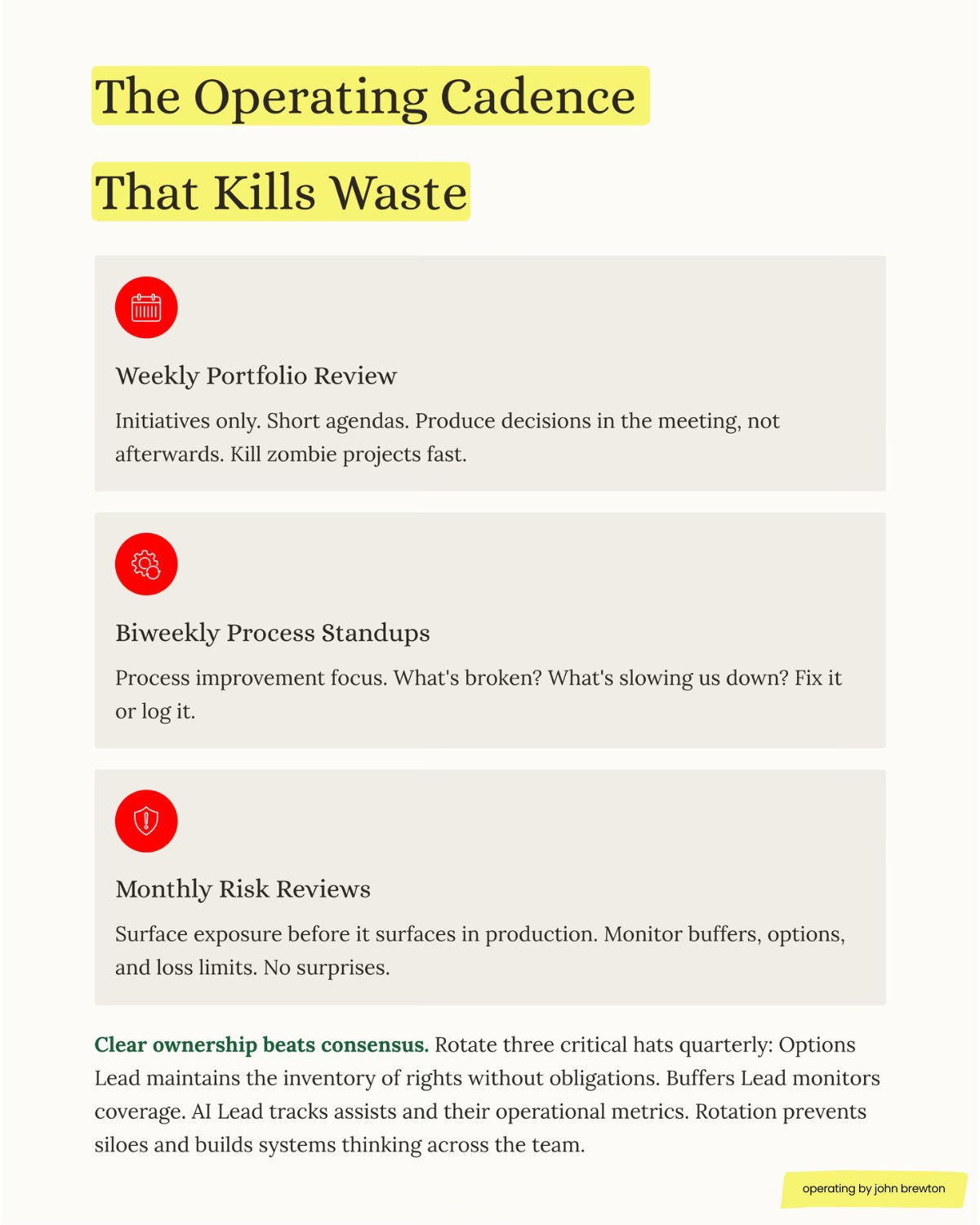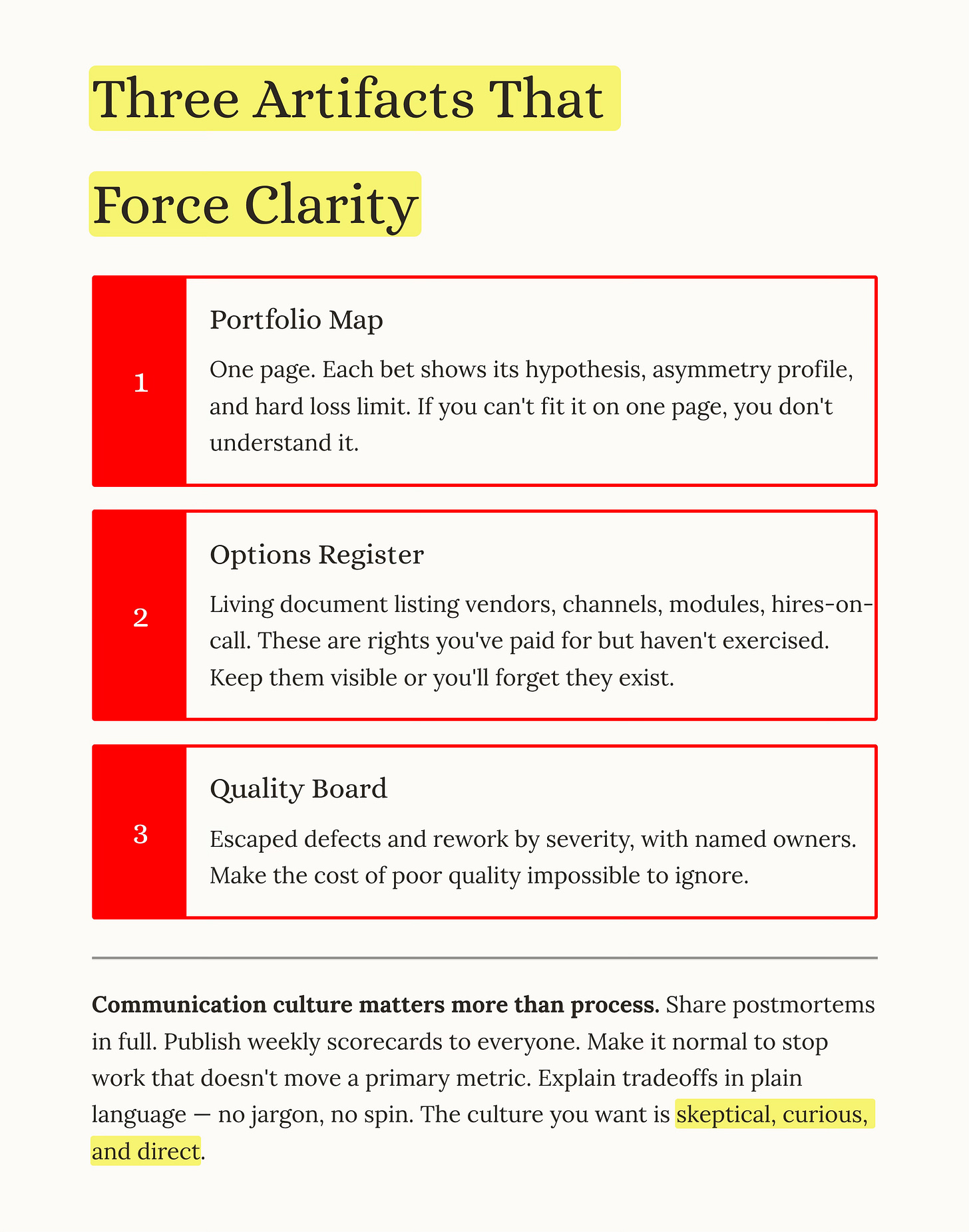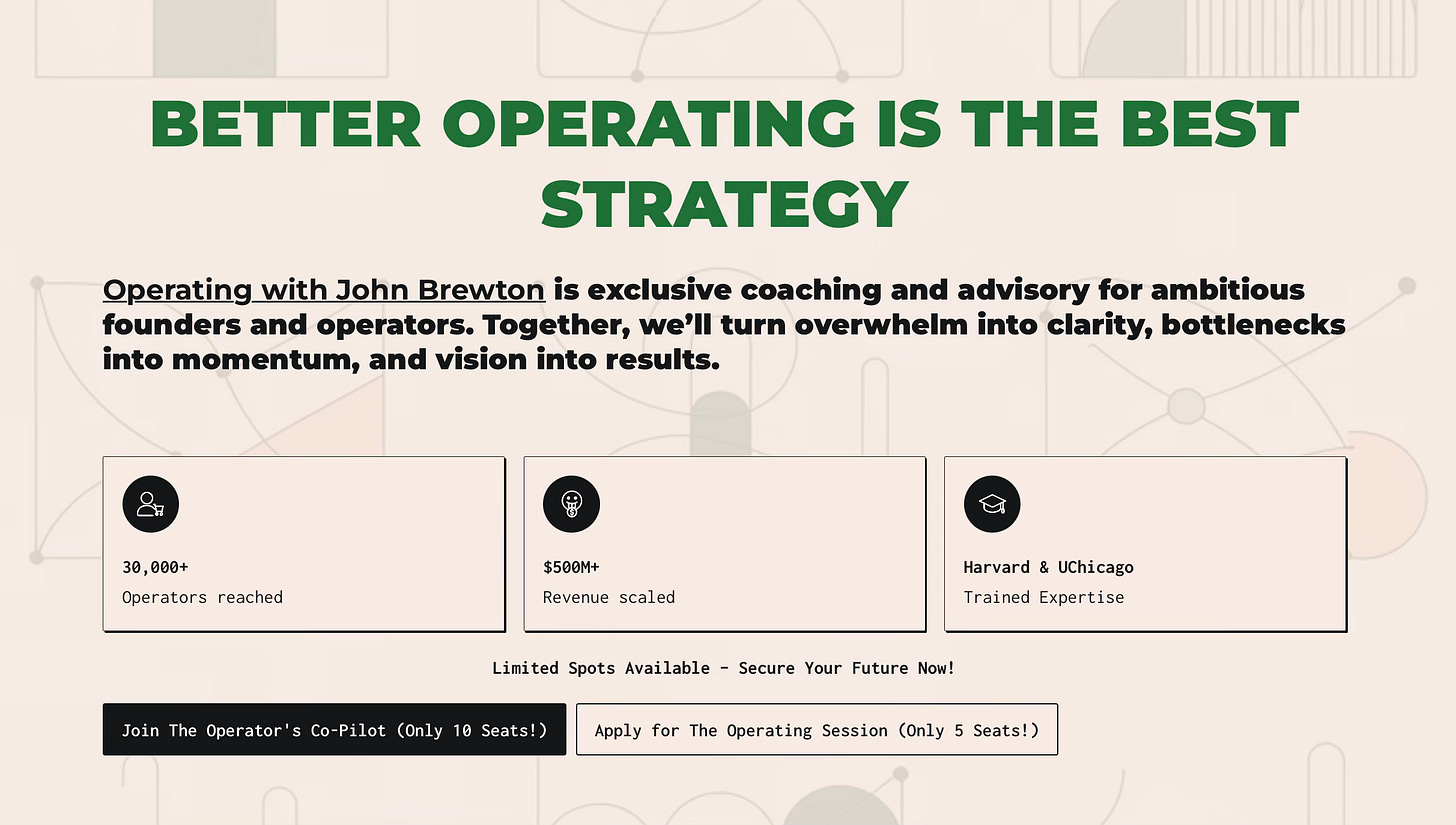Operating Economics: Building Antifragile Companies
A Practical Operating System for Uncertainty From the Brilliant Mind of Nassim Taleb
New to Operating by John Brewton?
Check out these reader favorites:
Most firms optimize for normal conditions. Competitive advantage goes to operators who design for volatility, who prefer options over forecasts, and who install simple rules that improve with stress.
Most of what follows is an application of Nassim Nicholas Taleb’s ideas to the work of operating a company. Taleb described systems that gain from disorder, not just survive it. He argued for optionality over prediction, improvement by subtraction rather than addition, and barbell strategies that keep most resources safe while placing small, convex bets. He warned that interventions can cause harm in complex systems, and that incentives must include skin in the game. This article translates those principles into operating practice.
We look at how an operator can structure exposure in Extremistan, where a few decisions drive most outcomes. We show how to build options in product and channel, where to add buffers, when to stop doing more and start removing fragility, and how to align decision rights with consequences. We keep the tools practical, from “boring AI” that trims defects and time, to weekly scorecards that track queue length, rework, and escaped defects. The aim is not rhetoric, it is a playbook that gets stronger when stressed.
What we’re drawing from Taleb’s work:
The Delusion of Robustness
Managers often treat volatility as a nuisance to be smoothed. That instinct can be costly. Fragile systems lose when stressed. Robust systems hold their level. Antifragile systems improve when hit by disorder. The operating goal is not to survive the average day. The goal is to get stronger when the improbable arrives.
Modern markets look more like Extremistan than Mediocristan. A small number of customers, features, or decisions drive a large share of outcomes. Averages can mislead. Prediction fails often; position matters more. The practical response is an operating system that favors asymmetry, preserves downside protection, and compounds small wins inside the flow of work.
Definitions
Fragile: performance declines under volatility, small errors escalate.
Robust: performance remains largely unchanged under volatility.
Antifragile: performance improves with volatility, stress becomes fuel.
This article proposes a practical OS to move teams along that spectrum.
Operating Context: Extremistan, Hormesis, and Systemic Learning
Extremistan vs Mediocristan: In Mediocristan, outcomes cluster around the mean. In Extremistan, tails drive totals. Technology markets, media, and venture portfolios operate in Extremistan. Variance is information, not noise. The operator’s task is to structure exposure so the right tails matter and the left tails are capped.
Hormesis: Biological systems become stronger through controlled exposure to stressors. Short bursts create overcompensation. Organizations can do the same. Small shocks, front-run in safe environments, produce learning that exceeds the initial hit. The method is simple: expose, observe, adapt, and then raise the dose.
Systemic learning: Individual failures can be expensive, system-level learning should not be. Spread trials across time and teams, then collect lessons into shared playbooks. Make the barrier to small tests low and the barrier to repeating known errors high.
Definitions
Optionality: owning rights, not obligations. More paths to upside, fewer paths to ruin.
Barbell: allocate most resources to safe assets, allocate a small slice to speculative bets with convex upside.
Strategic Pillars: Optionality and the Barbell
Build options on purpose: Options reduce the need to forecast. They increase the chance you are present when luck appears. Create option sets across product, channel, and partnership. Hold two or three credible distribution paths. Maintain one or two alternative suppliers for critical inputs. Keep a bench of pre-vetted contractors for surges. Store reusable code and templates. Write short internal APIs that make future combinations easy.
Design for convexity: Favor activities with limited downside and uncapped upside. Examples: feature flags that allow rapid rollback, licensing one module to new verticals, small branded experiments in new social channels, and low-cost landing pages that test demand. Avoid large irreversible commitments unless the payoff profile is asymmetric and the floor is known.
Run the barbell: Keep 80 to 90 percent of capital in proven work that pays the bills. Assign 10 to 20 percent to speculative work with the potential to change the slope. Protect the core with buffers and quality control. Protect the explore side with clear kill rules and pre-specified loss limits. The fragile middle, full of big mid-conviction bets without protection, is where firms blow up.
Portfolio literacy for operators: Treat initiatives as a portfolio, not a wish list. Each initiative should state the hypothesis, the asymmetry, the maximum loss, and the path to scale if it works. Review the portfolio weekly. Cull quickly. Double only when the variance that helps you is present.
Remove Fragility First: Via Negativa, Iatrogenics, Buffers, Touristification
Via negative: Subtraction often lowers risk faster than addition. Remove steps that add little signal. Stop initiatives that confuse the customer. Eliminate recurring meetings that yield no decision rights. Pause metrics that invite gaming. Reduction creates clarity, clarity reduces error, and error reduction compounds.
Iatrogenics: Well-intended interventions can cause harm in complex systems. New dashboards create thrash. New approval layers slow decisions. The test: if a change raises coordination load more than it raises signal, do not ship it. Prefer reversible changes. Ship with kill switches.
Buffers: Thin buffers amplify tail risk. Add slack where it matters: cash, inventory, server capacity, and time to decision on high-cost moves. Buffers turn shocks into learning, not layoffs. They also lower cognitive load, which improves judgment.
Touristification: When teams strip randomness from operations, they create a golden jail that performs in calm and fails in storms. Do not over-orchestrate. Keep a minimum level of controlled randomness in schedules, roles, and tests. Rotate critical duties. Run live-fire drills. Keep paper checklists for critical work in case tools fail.
The Accountability Engine: Decentralization and Skin in the Game
Antifragility requires aligned incentives. Push decision rights closer to the facts. Give teams clear boundaries, budgets, and kill rules. Require skin in the game. People who decide should share in the upside and the downside. Do not let risks migrate upward while rewards flow downward. That pattern kills learning.
Use small P&L cells where possible. Treat them like internal ventures. Give teams a compact scorecard and weekly cash visibility. Use internal pricing for shared services so tradeoffs are explicit. Tie variable compensation to the metrics that measure system health, not only top-line growth.
Ethical symmetry matters. If leadership collects upside from speculation, it should absorb reputational and financial costs when bets go wrong. That norm increases respect for downside management and raises the quality of debate.
Culture and Cognition: Debiasing the Operating System
Antifragility dies where story beats statistics. Build habits that correct for human bias.
Debiasing moves.
Premortems: before committing, ask how the project failed, then pre-install the mitigations.
Base rates: compare your plan to distributions from similar projects, then adjust down aspirations to match history.
Red teams: assign one person to articulate the strongest case against the dominant view.
Silent evidence: look for the missing data, not just the visible winners. Ask what you are not seeing.
Monte Carlo mindset: reason about ranges, not points. Demand sensitivity tables for key drivers.
Leadership Behaviors: Reward intelligent failure. Celebrate subtraction. Praise people who call time on sunk costs. Publish postmortems without blame. Train managers to speak in distributions and mechanisms, not slogans.
The Boring AI Layer: Quiet Compounding in the Flow of Work
Most AI value arrives in small increments. The goal is fewer escaped defects, faster cycle times, and more high-quality decisions per week. Keep it boring. Make it close to the work.
Five durable buckets.
Documentation and Retrieval: Summaries of calls and specs. Auto-generated SOP updates. Searchable knowledge with clear owners. Lower onboarding time, fewer repeated questions.
Decision Support: Structured prompts for pricing, discount approvals, and vendor selection. Scenario checklists embedded in forms. Confidence bands that nudge managers to run one more check.
Quality Control: Automated linting for code and copy. Review gates that detect inconsistency and non-compliance. Alerts on anomalous metrics.
Pattern Recognition: Early warning on churn risk, fraud, or demand spikes. Clustering that reveals customer segments worth a tailored offer.
Creative Augmentation: Variants of copy and creative that meet brand rules. Rapid concept tests with clear accept or reject thresholds.
Guardrails: Keep humans in the loop for irreversible decisions. Log prompts and outputs. Maintain audit trails. Train teams on failure modes, especially hallucination and overconfidence. Use synthetic data and red teaming to probe for weakness.
Operating Excellence as the Bridge
Antifragility is not an excuse to be sloppy. It is a plan to handle variance with discipline. Lean and quality methods still matter, they enable controlled exposure to stress.
Critical few: Identify the small set of processes that drive 80 percent of outcomes. Map them with simple swim lanes. Define defects clearly. Place checklists at the point of use. Shorten queues. Measure cycle times end to end, not in departmental fragments. Automate handoffs where reliability matters.
Scorekeeping: Use a compact, operator-facing scorecard: safety, quality, delivery, cost, and people. Add buffers and option value to make volatility explicit. Review weekly, decide weekly, and publish the changes.
AI and Excellence: Use AI to reduce rework, not to excuse it. Document with AI, then standardize the improved procedure. Use anomaly detection to catch drift. Close the loop with human review. Over time, the system becomes both tighter and more adaptive.
Metrics That Matter
Report weekly. Make the trend visible over twelve weeks. Link projects and experiments to a primary metric. Cull work that does not move the needle.
Definitions
Escaped Defect: any error that reaches a customer or downstream team without detection.
Buffer Coverage: time the firm can operate if inflows stop, split by cash, inventory, and capacity.
The 90-Day Mandate and Operator Checklist
Close: From Forecasts to Positioning
Volatility is not new. What is new is the number of ways it now enters the system. The answer is not better forecasting. The answer is better positioning. Build options. Protect the core. Subtract noise. Reward informed risk taking. Install boring AI where it trims defects and time. Use buffers to stay in the game and to pounce when rivals falter. Over time, the organization will not only survive shocks, it will harvest them.
Appendix: Implementation Notes for Leadership Teams
If you’d like to work together, I’ve carved out some time to work 1:1 each month with a few, top notch Founders and Operators. You can find the details here.
John Brewton documents the history and future of operating companies at Operating by John Brewton. He is a graduate of Harvard University and began his career as a Phd. student in economics at the University of Chicago. After selling his family’s B2B industrial distribution company in 2021, he has been helping business owners, founders and investors optimize their operations ever since. He is the founder of 6A East Partners, a research and advisory firm asking the question: What is the future of companies? He still cringes at his early LinkedIn posts and loves making content each and everyday, despite the protestations of his beloved wife, Fabiola, at times.



